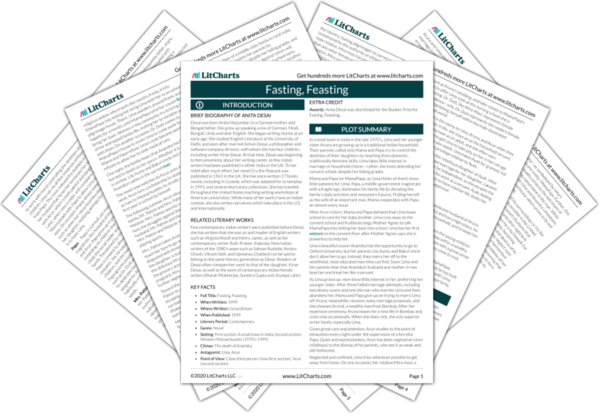Gender and Social Roles
The pressures and expectations placed on the different characters in the novel show the contrast in the social roles men and women are expected to fulfill, both in India and in the United States. While men are expected to be hard working, academic, and successful, the social value of women is dependent on their submissiveness, domestic abilities, beauty and child bearing.
Aruna and Uma are raised, educated, and groomed only with marriage in mind. When…
read analysis of Gender and Social RolesFamily Life and Individual Freedom
At the heart of many of the character’s stories lies a common search for freedom to be oneself and to carve out one’s own life path. The needs and desires of the individual are in constant tension with the demands of the family, which is the central social institution throughout the novel.
Uma’s desire for freedom is the central example: Constrained by her family’s needs and expectations, Uma yearns to be free, pushing against…
read analysis of Family Life and Individual FreedomPlenty/"Feasting" vs. Want/"Fasting"
Access to resources play a large factor in determining the quality of life and opportunity available to individual characters in the novel. Plenty and want are not what they appear to be, and characters who seem to have much are often found wanting; likewise, those who seem to have little are rich in spiritual ways. India is contrasted with America, and Uma’s lower middle class parents are contrasted with wealthier families in India.
Seeking…
read analysis of Plenty/"Feasting" vs. Want/"Fasting"
Tradition/India vs. Modernity/West
Throughout the novel, we see conflict between old ways, or ‘tradition’ running against new ways, or ‘modernity’. Most frequently, tradition is associated with India/Rural/Home/Extended Family/ Poverty/Fasting and modernity is associated with Western/Urban/Individuality/Commercialism/Feasting.
MamaPapa, from rural, humble roots, hold fast to traditional values, placing less value on daughters’ educations and more value on daughters’ obedience and preparation for marriage. The nuns at the convent and the Christian missionaries represent a western perspective in India that…
read analysis of Tradition/India vs. Modernity/WestLoneliness and Togetherness
The difference between loneliness and being alone is a tension that affects many characters throughout the novel. Loneliness affects many characters—yet, togetherness, especially within families, doesn’t always solve the loneliness of the individual. Balancing the needs for both community and solitude is a constant struggle, especially for Uma and Arun.
Within Indian society, individuals experience mental isolation within tight-knit families. The obligation to maintain a pretense of family harmony is isolating because individuals have…
read analysis of Loneliness and Togetherness






